Updated March 3, 2023. This article explains where Tram 28 stops and details all you need to know about Tram 28 – Lisbon’s rolling icon. Learn tips for riding, information about fares, and how to avoid the crowds.
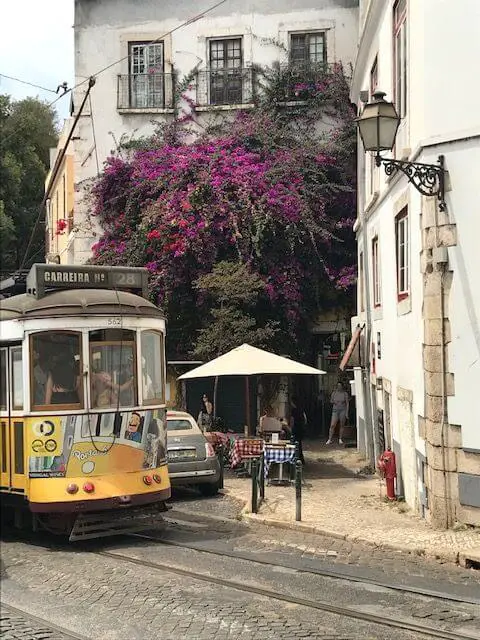
Where does Tram 28 stop?
There are 34 stops on the 4.5-mile-long route. Not all of them will be of interest to visitors. The full ride takes approximately 50 minutes depending on traffic.
- Praça Martim Moniz
- Rua da Palma
- Igreja dos Anjos
- Maria Andrade
- Maria Fonte
- Angelina Vidal
- Sapadores
- Rua da Graça
- Graça / Miradouro da Graça
- Voz Operário
- Calçada de São Vicente
- Escolas Gerais
- Largo das Portas do Sol
- Miradouro Santa Luzia
- Limoeiro
- Sé
- Conceição
- Largo da Academia Nacional Belas Artes
- Rua Vitor Cordon / Rua Serpa Pinto
- Chiado
- Praça Luis de Camões
- Calhariz
- Santa Catarina
- Calçada de Combro
- Poiais Sao Bento
- São Bento / Calçada da Estrela
- Calçada da Estrela / Rua Borges Carneiro
- Calçada da Estrela / Rua Dr. Teófilo Braga
- Basilica de Estrela
- Estrela – Rua Domingos Sequeira
- Domingos Sequeira
- Saraiva Carvalho
- Igreja Santo Condestável
- Campo Ourique (Prazeres)
Where does Tram 28 stop? A map
Interesting sites along the route of Tram 28
While Tram 28E is not an official tour, it does pass by some of the best sights that Lisbon has to offer, and the standing-room-only streetcar is a lot of fun.
I would not recommend trying to hop-on, hop-off. It won’t work. There is no room. Ride most, or all, of the route and then try to walk it later. Or take a bus up to the castle and then walk down the rest of the route after you have seen it from the tram.
Martim Moniz
Not far from Rossio Square, Praça da Figueira, and São Domingos Church, Praça Martim Moniz is the first stop on the route of Tram 28.
This square was named after Martim Moniz, a knight who fought in the siege on the Castelo de São Jorge in 1147.
He saw the opportunity to throw his body into the doorway of the castle as the door was being closed.
Although he was crushed, it allowed the Christian crusaders to enter the castle and seize it from the Muslims, changing the history of Portugal.
You are also in front of the Martim Moniz metro station.
On the far side of the metro station, you will find the unofficial Chinatown of Lisbon, with both its obvious and secret restaurants.
There are also two rooftop bars within a minute’s walk from Martim Moniz Square. To learn more, Best rooftop bars in Lisbon
Rua da Palma

As you ride north up Rua Almirante Reis, one of the most diverse areas of Lisbon, you will see Cervajaria Ramiro. It is possibly one of the best seafood restaurants in the world. See my Finding the best seafood in Lisbon
Make note of where it is because it is worth having a meal there while you are in town.
At Rua da Palma, you will see the limestone fountain, Chafariz do Intendente, which was built in 1823.
Graça
Located next to the Convento de Nossa Senhora da Graça, you will find fantastic views at this miradouro. See my, A guide to the beautiful Miradouro de Graça viewpoint
Voz Operário
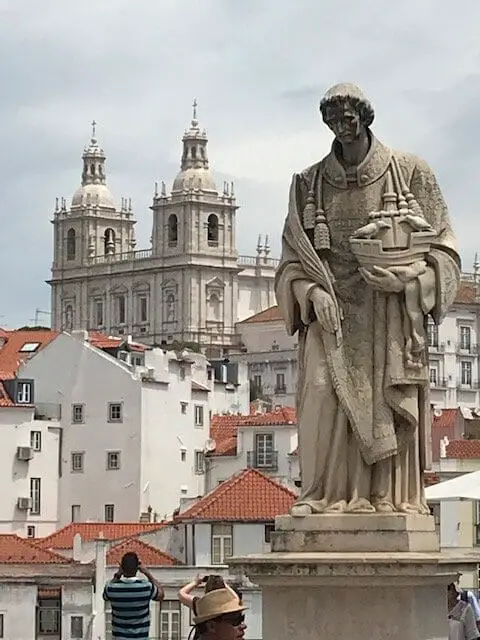
Visit the Church of São Vicente de Fora and the nearby National Pantheon. You are also close to the Santa Clara Market / Feira da Ladra / Thieves’ Market – a large flea market that is only open on Tuesdays and Saturdays.
Largo Das Portas Do Sol
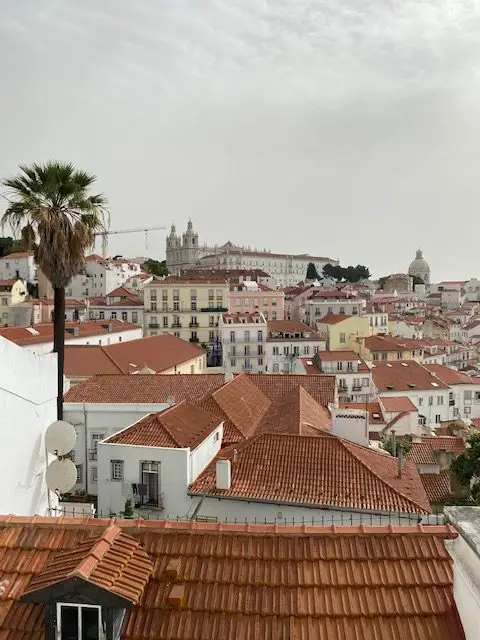
This is one of the best stops on the route of Tram 28. Here you will find one of the best scenic overlooks in Lisbon – Miradouro das Portas do Sol. This is the closest stop to Castelo São Jorge. From the tram stop to the castle, you will have a steep walk uphill. Also very close to another viewpoint, Miradouro de Santa Luzia.
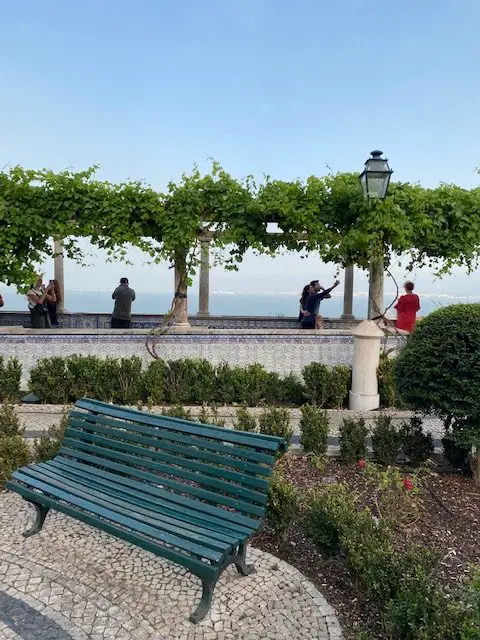
Sé
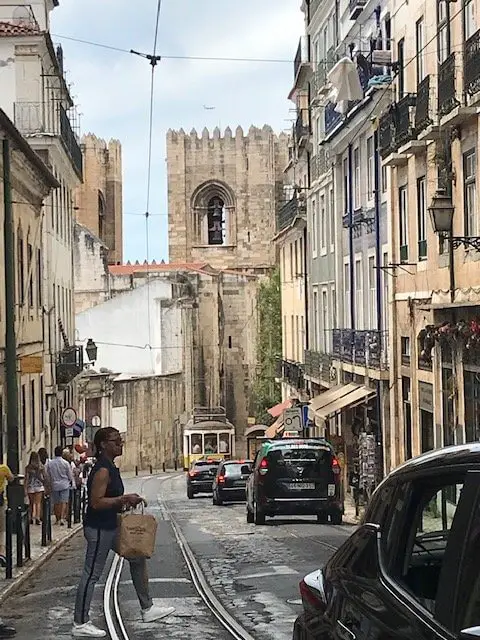
Short for “Seat of the Bishop,” Lisbon’s Sé Cathedral was built in 1147.
The imposing church also houses an archaeological dig that exposes Roman and Visigoth artifacts.
Also nearby, is the Igreja de Santo Antonio (Church of St. Anthony). The church was built on the site where he was born. St. Anthony is the patron saint of Lisbon.
Down the street is the Aljube Museum (formerly a prison, it is now a museum that remembers the victims of and the resistance to the Portuguese dictatorship), and the remains of the Roman Theatre.
Rua da Conceição
On flat land, downtown in the Baixa neighborhood, near Rua Augusta Arch and Rua Augusta shopping street, as well as Praça do Comércio and the Tejo River.
Chiado
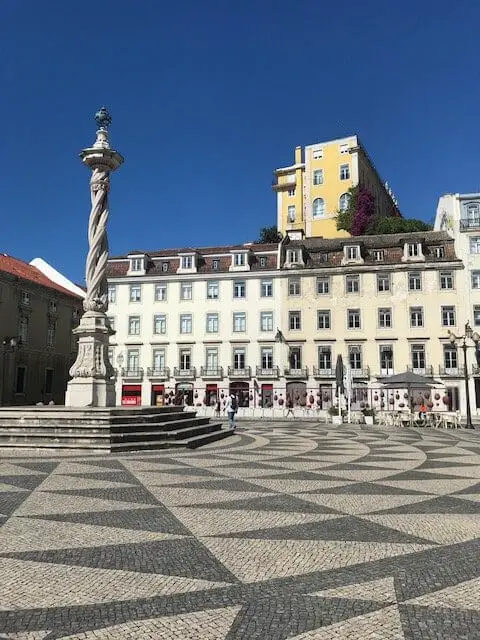
You will find shopping and fine dining on Rua Garrett, and nearby Praça Luís de Camões is the meeting spot for most of the city’s free walking tours.
Calhariz
Bica, West of Praça Luís de Camões, you will find the Elevador da Bica – one of the funiculars that pulls people up a very steep hill up to Bairro Alto. You can take some outstanding pictures at the top of this hill. Tram 28 stops right in front of the upper station.
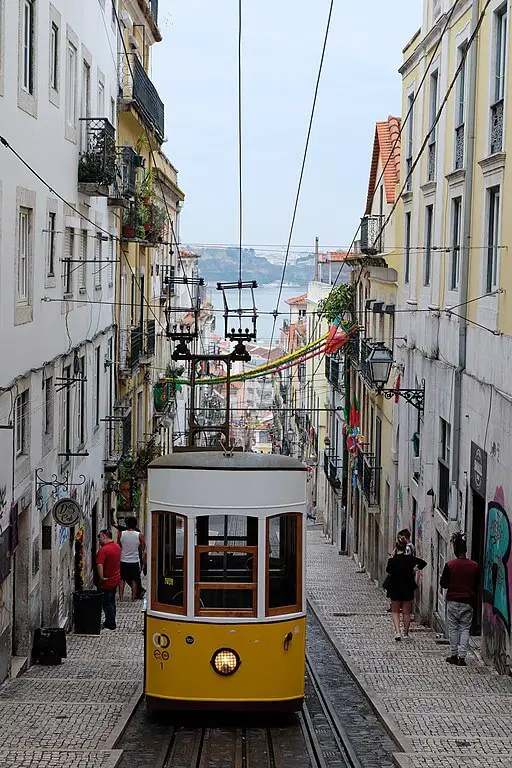
Santa Catarina
A few blocks west of the Elevador da Bica, Miradouro de Santa Catarina has great views of the 25 April Bridge and the Tagus River. You will also find the 16th-century Roccoco-style Igreja de Santa Catarina (St. Catherine’s Church) here.
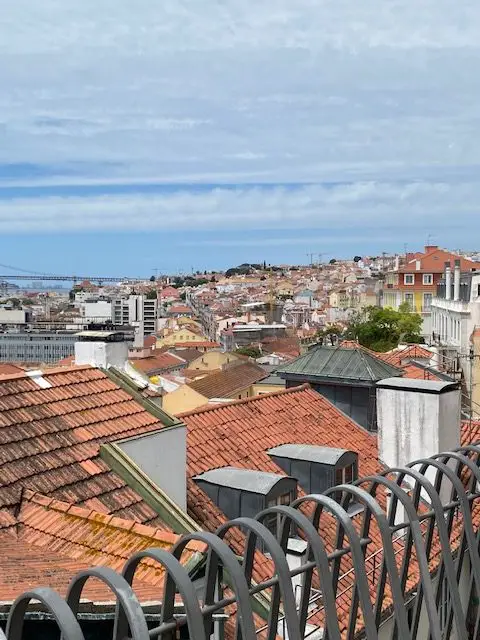
Rua Poiais De São Bento
Although you can’t enter the building, the 16th-century Mosteiro de São Bento (Monastery of St. Benedict) now houses the National Parliament.
Estrela
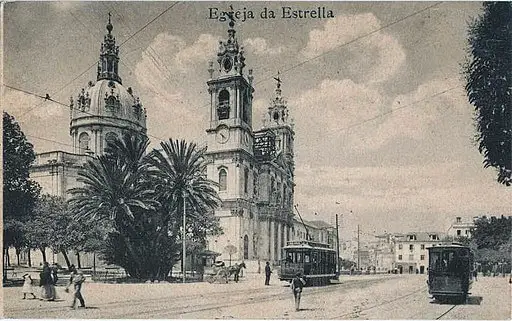
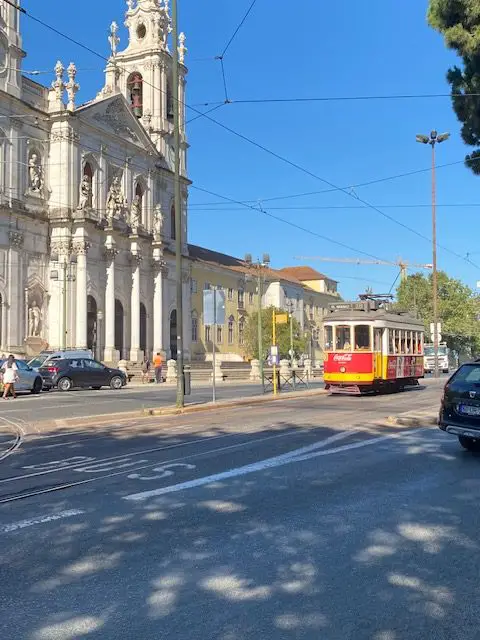
See the Jardim da Estrela garden and the Basílica da Estrela church. Construction on this church started in 1779.
The church is famous for its 500-piece nativity scene. Tram 28 stops right in front of the church.
Campo de Ourique /Prazeres

This is the last stop of Tram 28. You have to get off here and pay again to ride back in the other direction, but the line is not usually very long here.
The Prazeres (Pleasures) Cemetery is here. Many notable names in Portuguese history can be found here, and the cemetery has good views of the 25 April Bridge.
Also nearby is the Mercado de Campo Enrique, with its food hall. Campo Ourique is the end of the line for Tram 28.
If you want to head back in the opposite direction, hop off and get on one going the other way.
How long does it take to ride Tram 28?
First, you may spend over an hour waiting in line at Martim Moniz Square.
If you get on there and decide to ride to the last stop at Campo De Ourique, that could take an additional 50 minutes, depending on traffic.
In general, another Tram comes by every 15 minutes, as long as they are not delayed.
What is the schedule for Tram 28?
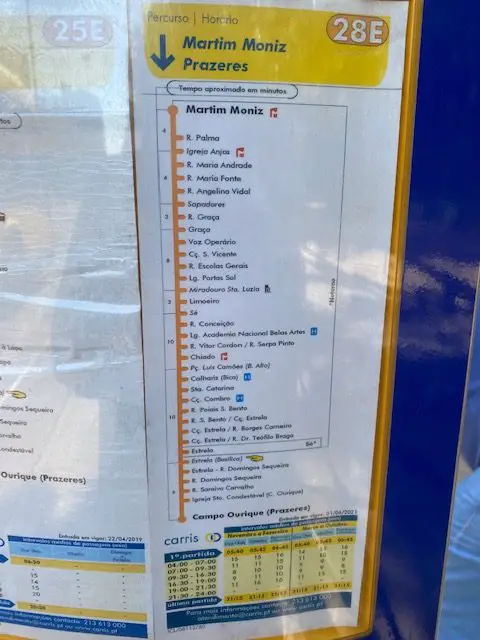
The first Tram leaves Martim Moniz at 5:40 am. The last Tram to leave from Martim Moniz is at 9:15 pm. After that, they shorten the route, and trams continue to depart from Graça until 11:10 pm.
How much does it cost to ride Tram 28?
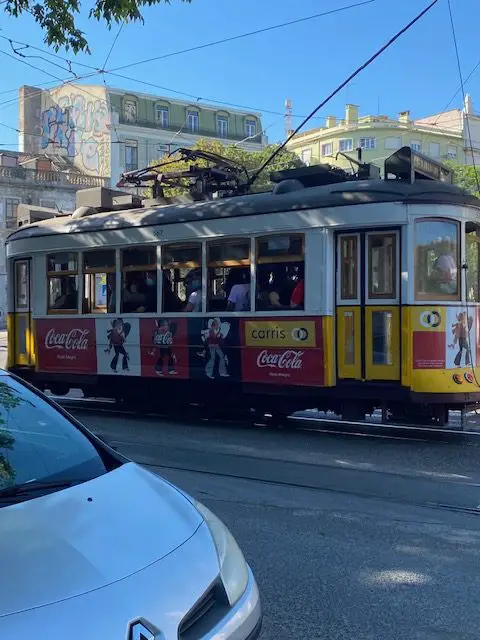
It costs €3 to ride Tram 28 if you pay cash, but if you use the Viva Viagem card to pay, then you are only charged €1.80. Viva Viagem cards cannot be purchased on the tram. You must by them at a metro station.
You can also buy a 24-hour travel pass on the Viva Viagem card for €6.40, and then your ride is free.
You can also ride all buses, metros, elevators, and trams for free in that 24 hour period. For more information on the Viva Viagem Card, see my article, What is the Viva Viagem Card? Everything you need to know
Another option is to buy a Lisboa Card from the Chamber of Commerce.
This card also provides free transportation, free admission to certain museums, and discounts to other sites for a period of either 24, 48, or 72 hours. All the details are in my article, Lisboa Card | Everything you need to know .
Regardless, Be sure to enter through the front door and then validate your ticket in the machine behind the driver.
How to avoid the lines for Tram 28
Arrive at Martim Moniz prior to 8 am or after 9 pm.
Actually, if you want to take good Instagram shots or travel photos, you need to get out into the city before the crowds start moving.
Another way to beat the crowds is to take bus 709 from Restauradores square and then get off at the last stop. Board the tram at Campo D’Ourique and ride in the opposite direction without having to fight for space.
Other options instead of riding Tram 28E
If the lines for Tram 28 are too long, you could try Tram 12. Tram 12 is also a Remodelado tram and does a circular loop of Baixa and Alfama, stopping at many, but not all, of the same stops as Tram 28.
Another Remodelado tram that does not follow the prime sight-seeing route is Tram 24. Always less crowded, this tram connects Praça Luís de Camões to Campolide.
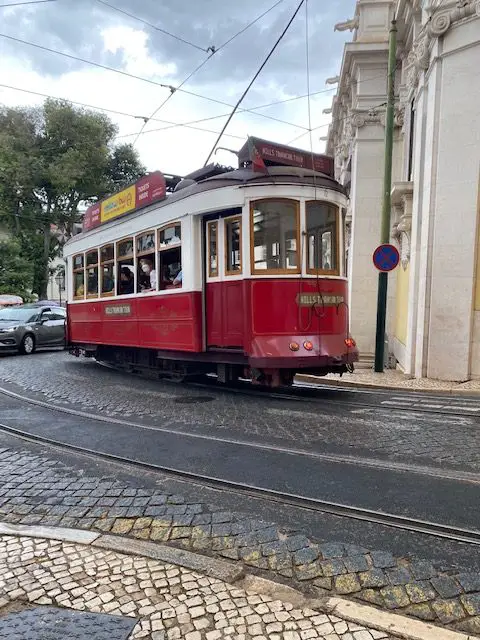
There is also the Red tourist tram, which is actually a guided tour that follows much of the same route. Tickets are good for 24 hours, and you can hop on and off wherever you like. Tickets are €22 for adults. https://www.yellowbustours.com/en/lisbo
Beware of Pickpockets
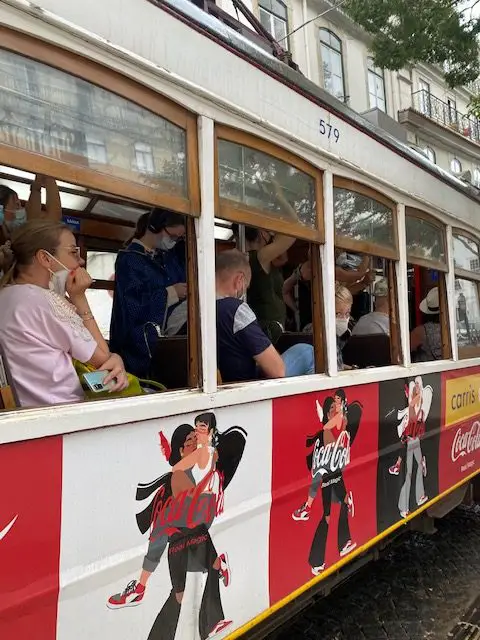
Some of the best pickpockets in the world work on Tram 28. And you are going to be busy looking at all of the sites as you ride across town.
If you are planning on taking Tram 28, maybe don’t bring along all of your cash and credit cards. Don’t bring your passport.
Bring your phone or camera so that you can take pictures, but have it in your hand.
History of Lisbon’s Trams
Lisbon’s tram service started in 1873. They went electric in 1901, hence the trams are called “Elétricos” and have an “E” next to the number.
Tram 28 started running in 1914.
Use of the trams declined in the 1950s with more cars on the scene and the metro being built, but has increased as Portugal saw a tourism boom.
Even with the metro, the trams are still the best ways to traverse Lisbon’s many hills that the metro does not serve.
Today there are five tram lines – 12, 15, 18, 25, 28. 15E is a modern tram, the others are vintage Remodelado Trams.
Remodelado Trams
The iconic Lisbon tram is a bright yellow wooden cablecar built in the 1930s. It has uncomfortable polished wood seating for 20 and standing room for 30.
The trams also have polished brass fixtures.
The driver is called the brakeman, or “guarda freios.”
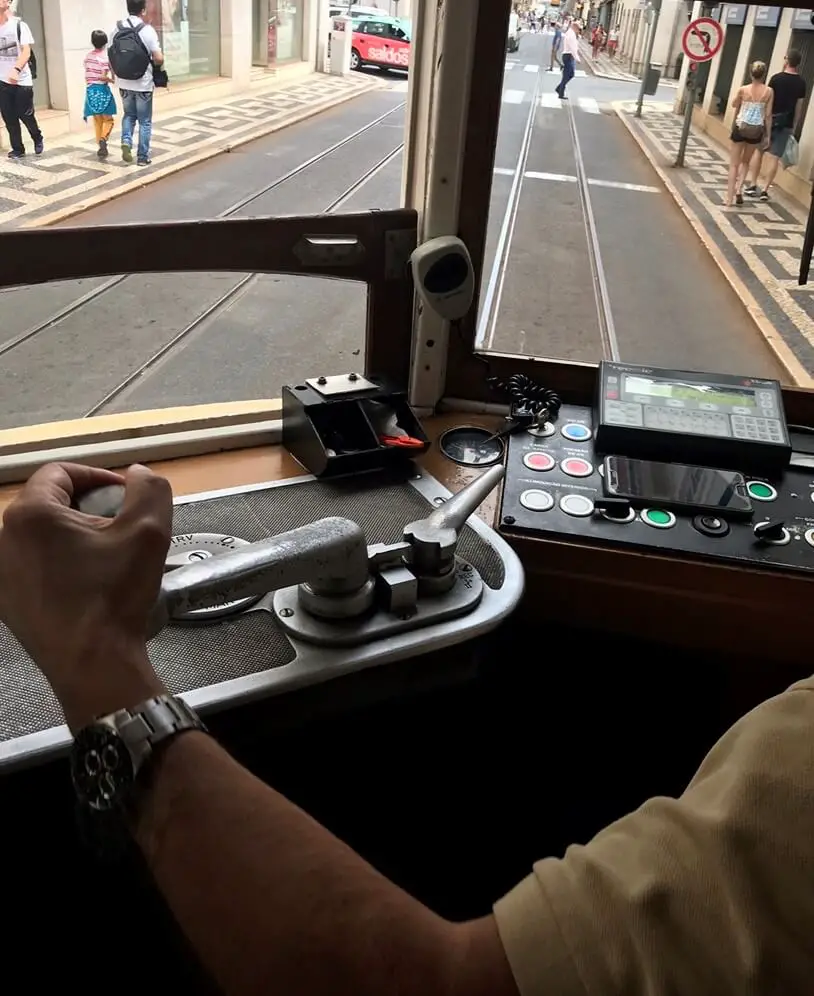
The trams were “remodelados” (remodeled) in 1996 with brakes and electronics. The wagons can reach speeds of up to 31 mph (50 km/h).
The brakes can be quite loud, and you pass so close to buildings that you can often touch them as you fly through the alleys.
But then the driver hits the brakes to avoid a car that is parking or that is sitting on the tracks, causing delays.
Thank you for taking the time to read “Where does Tram 28 stop? All you need to know about Tram 28.” For more information on public transportation in Lisbon, try my article How to ride Lisbon’s trolleys, cable cars, elevators, and buses .
You can also use public transportation to explore the area’s beaches. How to use public transportation to get to Lisbon’s beaches
You will also want to find lodging that is central and has easy access to public transportation. Try my article Hotels located near metro stations in Lisbon
If you are on more of a budget, you can still have convenience. 15 Great Lisbon Hostels Near Metro Stops .
If you buy anything from a link in this article, I may earn a small commission. Thank you for reading “Where does Tram 28 stop?”